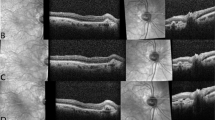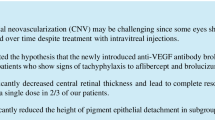Abstract
Background
Anti-vascular endothelial growth factor (anti-VEGF) agents have been shown to be effective in the treatment of neovascular age-related macular degeneration (AMD). Efficacy and safety of intravitreally administered bevacizumab (Avastin), a humanized monoclonal anti-VEGF, was assessed in minimally classic and occult subfoveal choroidal neovascularization (CNV) due to AMD.
Methods
A prospective interventional study was carried out. Bevacizumab (1.25 mg) was administered intravitreally on a 6-week basis until macular edema, subretinal fluid, and/or pigment epithelial detachment had resolved. Administration was repeated in case of relapse. Ophthalmic evaluations included a complete ophthalmic examination, measurement of the visual acuity (VA), optical coherence tomography, and fluorescein angiography. Main outcome measures were the changes between baseline and last follow-up visit in best-corrected VA, central foveal thickness (CFT) and total macular volume (TMV).
Results
From 102 patients [mean age (range) 74.8 (61–85) years], 102 eyes were included. Median (range) duration of follow-up was 18 (6–24) weeks. Statistically significant changes from baseline were observed in best-corrected VA [increase of 1.29 lines (P=0.001)], CFT [reduction of 56 μm (P=0.01)] and TMV [reduction of 0.80 mm3 (P<0.0001)]. Positive results were obtained in 65/102 (64%) patients after two to three injections as a mean. In a substantial proportion of patients (38%) followed up for at least 18 weeks, recurrence of leakage requiring additional injections was observed. Treatment was well tolerated; two pigment epithelium rips and ten posterior vitreous detachments were reported.
Conclusions
Short-term results suggest that intravitreally administered bevacizumab (Avastin) is effective in minimally classic and occult CNV due to AMD. Significant improvements in VA, CFT and TMV were obtained and maintained during follow-up. In some patients, however, recurrence of leakage requiring additional intravitreal injection occurred. Maintenance of the effect of bevacizumab and its safety after repeated and prolonged administration have to be investigated in well-controlled studies.


Similar content being viewed by others
References
Polito A, Isola M, Lanzetta P, Gregori D, Bandello F (2006) The natural history of occult choroidal neovascularization associated with age-related macular degeneration. A systematic review. Ann Acad Med Singapore 35:145–150
Verteporfin in Photodynamic Therapy Study Group (2001) Verteporfin therapy of subfoveal choroidal neovascularization in age-related macular degeneration: two year results of randomized clinical trial including lesions with occult with no classic choroidal neovascularization-Vereporfin in photodynamic therapy report 2. Am J Ophthalmol 131:541–560
Azab M, Boyer DS, Bressler NM, Bressler SB, Cihelkova I, Hao Y, Immonen I, Lim JI, Menchini U, Naor J, Potter MJ, Reaves A, Rosenfeld PJ, Slakter JS, Soucek P, Strong HA, Wenkstern A, Su XY, Yang YC (2005) Verteporfin therapy of subfoveal minimally classic choroidal neovascularization in age-related macular degeneration: 2-year results of a randomized clinical trial. Arch Ophthalmol 123(4):448–457
Ferrara N (2004) Vascular endothelial growth factor: basic science and clinical progress. Endocr Rev 25:581–611
Adamis AP, Shima DT (2005) The role of vascular endothelial growth factor in ocular health and disease. Retina 25:111–118
Treatment of Age-Related Macular Degeneration with Photodynamic Therapy (TAP) Study Group, Verteporfin in Photodynamic therapy Study Group (2003) Photodynamic therapy of subfoveal choroidal neovascularization with verteporfin: fluorescein angiographic guidelines for evaluation and treatment—TAP and VIP report no 2. Arch Ophthalmol 121:1253–1268
Miller J, Chung CY, Kim RY, MARINA Study Group (2005) Randomized, controlled phase III study of ranibizumab (Lucentis) for minimally classic or occult neovascular age-related macular degeneration. Program and abstracts of the American Society of Retina Specialists 23rd Annual Meeting; July 16–20, Montreal, Canada
Bartz-Schmidt KU, Holz FG (2006) Introduction to the topic: off-label use of bevacizumab in the treatment of neovascular age-related macular degeneration. Ophthalmologe 103:461–462
Ladewig MS, Ziemssen F, Jaissle G, Helb HM, Scholl HP, Eter N, Bartz-Schmidt KU, Holz FG (2006) Intravitreal bevacizumab for neovascular age-related macular degeneration. Ophthalmologe 103:463–470
Niemeyer M, Hefner L, Jochmann C, Wiedemann P (2006) Intravitreal Bevacizumab for recurring choroidal neovascularisation. Ophthalmologe (in press)
Avery RL, Pieramici DJ, Rabena MD, Castellarin AA, Nasir MA, Giust MJ (2006) Intravitreal bevacizumab (Avastin) for neovascular age-related macular degeneration. Ophthalmology 113:363–372
Michels S, Rosenfeld PJ, Puliafito CA, Marcus EN, Venkatraman AS (2005) Systemic bevacizumab (Avastin) therapy for neovascular age-related macular degeneration: twelve-week results of an uncontrolled open-label clinical study. Ophthalmology 112:1035–1047
Nguyen QD, Shah S, Tatlipinar S, Do DV, Anden EV, Campochiaro PA (2005) Bevacizumab suppresses choroidal neovascularisation caused by pathological myopia. Br J Ophthalmol 89:1368–1370
Spaide RF, Laud K, Fine HF, Klancnik JM Jr, Meyerle CB, Yannuzzi LA, Sorenson J, Slakter J, Fisher YL, Cooney MJ (2006) Intravitreal bevacizumab treatment of choroidal neovascularization secondary to age-related macular degeneration. Retina 26:383–390
Grisanti S, Biester S, Peters S, Tatar O, Ziemssen F, Bartz-Schmidt KU, Tuebingen Bevacizumab Study Group (2006) Intracameral bevacizumab for iris rubeosis. Am J Ophthalmol 142:158–160
Jaissle GB, Ziemssen F, Petermeier K, Szurman P, Ladewig M, Gelisken F, Volker M, Holz FG, Bartz-Schmidt KU (2006) Bevacizumab for treatment of macular edema secondary to retinal vein occlusion. Ophthalmologe 103:471–475
He AR, Marshall J (2005) Biologic therapy for colon cancer. Clin Adv Hematol Oncol 3:555–561
Augustin AJ, Schimdt-Erfurth U (2006) Verteporfin therapy with intravitreal triamcinolone in all types of choroidal neovascularization due to age-related macular degeneration. Ophthalmology 113:14–22
Jonas JB, Kreissig I, Hugger P, Sauder G, Panda-Jonas S, Degenring R (2003) Intravitreal triamcinolone acetonide for exudative age-related macular degeneration. Br J Ophthalmol 87:462–468
Spaide RF, Sorenson J, Maranan L (2003) Combined photodynamic therapy with verteporfin and intravitreal triamcinolone acetonide for choroidal neovascularization. Ophthalmology 110:1517–1525
Mordenti J, Cuthbertson RA, Ferrara N, Thomsen K, Berleau L, Licko V, Allen PC, Valverde CR, Meng YG, Fei DT, Fourre KM, Ryan AM (1999) Comparison of the intraocular tissue distribution, pharmacokinetics, and safety of 125I-labeled full-length and FAB antibodies in rhesus monkeys following intravitreal administration. Toxicol Pathol 27:536–544
Treatment of Age-Related Macular Degeneration with Photodynamic Therapy (TAP) Study Group, Verteporfin in Photodynamic therapy Study Group (2003) Photodynamic therapy of subfoveal choroidal neovascularization with verteporfin: fluorescein angiographic guidelines for evaluation and treatment—TAP and VIP report no 2. Arch Ophthalmol 121:1253–1268
Shahar J, Avery RL, Heilweil G (2006) Electrophysiologic and retinal penetration studies following intravitreal injection of bevacizumab (Avastin). Retina 26:262–269
Meyer CH, Mennel S, Schmidt JC, Kroll P (2006) Acute retinal pigment epithelial tear following intravitreal bevacizumab (Avastin) injection for occult choroidal neovascularisation secondary to age related macular degeneration. Br J Ophthalmol 90:1207–1208
Van Wijengaarden P, Costner DJ, Williams KA (2005) Inhibitors of ocular neovascularization :promise and potential problems. JAMA 293:1509–1513
Luke M, Warga M, Ziemssen F, Gelisken F, Grisanti S, Schneider T, Luke C, Partsch M, Bartz-Schmidt KU, Szurman P, Tuebingen Bevacizumab Study Group (2006) Effects of bevacizumab on retinal function in isolated vertebrate retina. Br J Ophthalmol 9:1178–1182
Manzano RP, Peyman GA, Khan P, Kivilcin M (2006) Testing intravitreal toxicity of bevacizumab (Avastin). Retina 26:257–261
Ignoffo RJ (2004) Overview of bevacizumab: a new cancer therapeutic strategy targeting vascular endothelial growth factor. Am J Health Syst Pharm 61 [21 Suppl 5]:S21–S26
Author information
Authors and Affiliations
Corresponding author
Additional information
We, the authors, have not received any financial support from an agency or person in conducting this study, and we have no proprietary interest to report. We, the authors have full control of all primary data and Graefe’s Archive for Clinical and Experimental Ophthalmology is welcomed to review our data upon request.
Rights and permissions
About this article
Cite this article
Lazic, R., Gabric, N. Intravitreally administered bevacizumab (Avastin) in minimally classic and occult choroidal neovascularization secondary to age-related macular degeneration. Graefe's Arch Clin Exp Ophthalmol 245, 68–73 (2007). https://doi.org/10.1007/s00417-006-0466-4
Received:
Revised:
Accepted:
Published:
Issue Date:
DOI: https://doi.org/10.1007/s00417-006-0466-4




